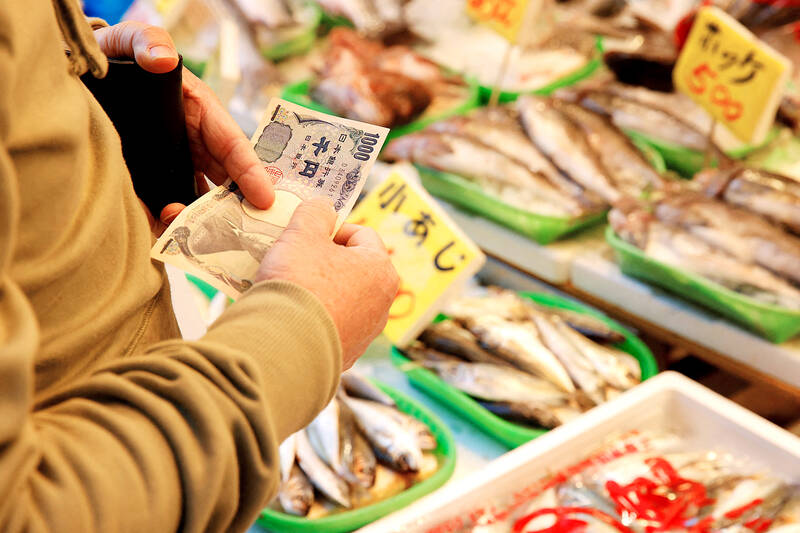Japan’s inflation re-accelerated last month after cooling earlier in the year, likely supporting views that the central bank might have to revise its price outlook, bringing the Bank of Japan (BOJ) a step closer to policy normalization.
Consumer prices excluding fresh food rose 3.4 percent from a year ago, quickening from the previous month, driven by gains in processed food and hotel prices, the Japanese Ministry of Internal Affairs and Communications reported yesterday.
The result came in line with analysts’ forecasts.

Photo: Reuters
The national data were consistent with the results of the leading Tokyo figures, which showed renewed upward momentum after two months of deceleration.
The acceleration in the key inflation gauge is likely to cement the view of many BOJ watchers that the central bank would bump up its price forecasts, leading to speculation over policy adjustment as early as July.
“These are very strong figures,” Dai-Ichi Life Research Institute senior executive economist Yoshiki Shinke said.
Underlying inflation “continues to accelerate, reflecting businesses passing their costs onto consumers. There is no doubt that the BOJ will raise its inflation outlook for this fiscal year in July,” he said.
In the latest quarterly outlook report, the BOJ projected core prices rising at just 1.6 percent in fiscal 2025, implying that the bank’s 2 percent sustainable inflation goal would not be achieved within its forecast period.
At the same time, new BOJ Governor Kazuo Ueda has indicated that once the inflation target comes into sight, he would adjust existing policy, including the yield curve control program.
Processed foods continued to drive overall inflation, boosting it by 2 percentage points. Food prices rose 9 percent compared with the previous year, the biggest jump since 1976. Service costs increased 1.7 percent, the biggest gain since 1995 excluding the impact of sales tax hikes.
Prices excluding the impact from energy and fresh food, a measure of the deeper inflation trend, also quickened to the fastest pace since 1981.
Food price hikes also do not seem to be ending anytime soon. The prices of about 5,600 food items are expected to rise from next month, a Teikoku Databank report said.
“Food price increases will continue at least until this fall,” the data firm said.

Hong Kong authorities ramped up sales of the local dollar as the greenback’s slide threatened the foreign-exchange peg. The Hong Kong Monetary Authority (HKMA) sold a record HK$60.5 billion (US$7.8 billion) of the city’s currency, according to an alert sent on its Bloomberg page yesterday in Asia, after it tested the upper end of its trading band. That added to the HK$56.1 billion of sales versus the greenback since Friday. The rapid intervention signals efforts from the city’s authorities to limit the local currency’s moves within its HK$7.75 to HK$7.85 per US dollar trading band. Heavy sales of the local dollar by

Taiwan Semiconductor Manufacturing Co’s (TSMC, 台積電) revenue jumped 48 percent last month, underscoring how electronics firms scrambled to acquire essential components before global tariffs took effect. The main chipmaker for Apple Inc and Nvidia Corp reported monthly sales of NT$349.6 billion (US$11.6 billion). That compares with the average analysts’ estimate for a 38 percent rise in second-quarter revenue. US President Donald Trump’s trade war is prompting economists to retool GDP forecasts worldwide, casting doubt over the outlook for everything from iPhone demand to computing and datacenter construction. However, TSMC — a barometer for global tech spending given its central role in the

The Financial Supervisory Commission (FSC) yesterday met with some of the nation’s largest insurance companies as a skyrocketing New Taiwan dollar piles pressure on their hundreds of billions of dollars in US bond investments. The commission has asked some life insurance firms, among the biggest Asian holders of US debt, to discuss how the rapidly strengthening NT dollar has impacted their operations, people familiar with the matter said. The meeting took place as the NT dollar jumped as much as 5 percent yesterday, its biggest intraday gain in more than three decades. The local currency surged as exporters rushed to

PRESSURE EXPECTED: The appreciation of the NT dollar reflected expectations that Washington would press Taiwan to boost its currency against the US dollar, dealers said Taiwan’s export-oriented semiconductor and auto part manufacturers are expecting their margins to be affected by large foreign exchange losses as the New Taiwan dollar continued to appreciate sharply against the US dollar yesterday. Among major semiconductor manufacturers, ASE Technology Holding Co (日月光), the world’s largest integrated circuit (IC) packaging and testing services provider, said that whenever the NT dollar rises NT$1 against the greenback, its gross margin is cut by about 1.5 percent. The NT dollar traded as strong as NT$29.59 per US dollar before trimming gains to close NT$0.919, or 2.96 percent, higher at NT$30.145 yesterday in Taipei trading